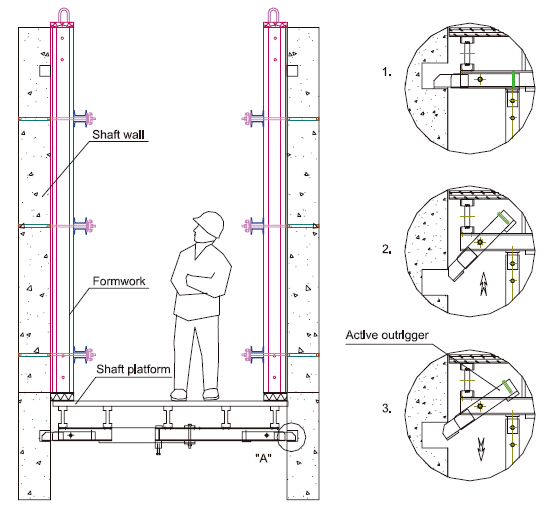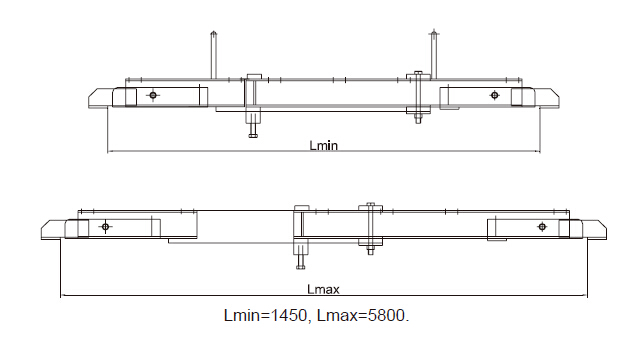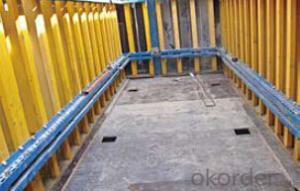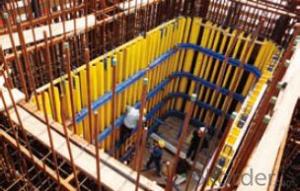Shaft-Platform System For Formwork and Scaffolding
- Loading Port:
- Tianjin
- Payment Terms:
- TT OR LC
- Min Order Qty:
- 50 m²
- Supply Capability:
- 1000 m²/month
OKorder Service Pledge
Quality Product, Order Online Tracking, Timely Delivery
OKorder Financial Service
Credit Rating, Credit Services, Credit Purchasing
You Might Also Like
Shaft Platform
As operating platform, the shaft platform is mainly used in the concrete pouring of elevator shaft,
equipment shaft, stair shaft of high-rise building and so on.
Characteristics:
◆ The length of shaft beam is adjustable.
◆ Flexible structure makes lifting easier.


- Q:Can steel formwork be used for industrial structures?
- Indeed, steel formwork proves to be a viable option for constructing industrial structures. This method involves utilizing steel panels or sheets to establish temporary molds or frameworks, which then hold and shape the concrete throughout the construction process. The utilization of steel formwork is particularly favored in industrial construction due to its robustness, durability, and capacity to endure heavy loads and high pressures. The construction of industrial structures often necessitates formwork systems that can withstand the weight of substantial concrete pours and provide ample support during the curing phase. Steel formwork showcases these qualities, rendering it an ideal selection for industrial projects. Furthermore, steel formwork guarantees exceptional dimensional accuracy, ultimately ensuring precise and consistent outcomes in the construction of industrial structures. Additionally, it can be easily adjusted and reused, leading to cost savings and improved efficiency throughout the construction process. Another notable advantage of steel formwork lies in its ability to withstand adverse weather conditions and extreme temperatures, thus rendering it suitable for a diverse range of industrial settings. Its resistance to warping, cracking, and other forms of damage ultimately safeguards the structure's integrity and longevity. Moreover, steel formwork can be customized to meet the specific requirements of various industrial structures, thereby allowing for flexibility in design and construction. Its ease of assembly and disassembly facilitates faster construction cycles and reduces overall project timelines. To conclude, steel formwork emerges as an exceedingly suitable choice for industrial structures due to its strength, durability, dimensional accuracy, weather resistance, and flexibility. The numerous advantages it offers over alternative formwork materials position it as the preferred option within the construction industry.
- Q:Can steel formwork be used for complex architectural designs?
- Complex architectural designs can indeed utilize steel formwork. Steel, being a versatile and durable material, can be molded and shaped into intricate designs, making it highly suitable for complex architectural projects. The utilization of steel formwork offers numerous advantages, including high strength, stability, and consistency, which are crucial for the creation of complex shapes and structures. Moreover, steel formwork enables precise and accurate construction, guaranteeing the faithful execution of the final design. In conclusion, steel formwork is a dependable and efficient option for accomplishing complex architectural designs.
- Q:How does steel formwork affect the overall construction productivity?
- Steel formwork revolutionizes the construction process by utilizing metal panels and supports to create temporary molds or frames for pouring concrete. This innovative technique offers numerous advantages over traditional timber formwork, including increased durability, reusability, and design flexibility. Consequently, steel formwork has a profound impact on construction productivity in multiple ways. To begin with, the utilization of steel formwork leads to heightened construction efficiency by reducing the time required for assembly and dismantling. Unlike timber formwork, steel panels are prefabricated and easily interconnected, allowing for swift installation and disassembly. This results in reduced labor hours and faster completion of formwork activities, ultimately accelerating the construction process. Moreover, the durability of steel formwork positively influences productivity. Steel panels have the ability to withstand harsh weather conditions, extreme temperatures, and heavy loads, ensuring their longevity and reusability. Consequently, contractors can reuse steel formwork on multiple projects, eliminating the need for frequent replacement and reducing material costs. The ability to reuse formwork not only saves time and money but also minimizes waste generation and promotes sustainability in the construction industry. Additionally, steel formwork offers greater flexibility in design, enabling the construction of complex structures with precision. The modular and adjustable nature of steel panels allows for easy customization according to project requirements, resulting in accurate and consistent concrete placements. This precision eliminates the need for excessive concrete rework, reducing material waste and saving construction time. The speed and accuracy provided by steel formwork positively impact overall construction productivity. Furthermore, steel formwork enhances safety on construction sites. Its sturdy structure and secure connections ensure stability during concrete pouring, minimizing the risk of accidents or structural failures. This increased safety reduces downtime caused by injuries or damages, ultimately improving productivity by maintaining a continuous workflow. In conclusion, steel formwork has a significant impact on overall construction productivity through various means. Its quick assembly and dismantling, durability, reusability, flexibility in design, and improved safety contribute to faster construction processes, reduced material waste, and enhanced efficiency. Embracing steel formwork techniques can lead to significant time and cost savings, ultimately benefiting the construction industry as a whole.
- Q:What is the maximum load capacity of steel formwork?
- The maximum load capacity of steel formwork can differ based on various factors, including steel thickness and quality, formwork system design, and the type of load applied. Steel formwork is generally recognized for its ability to bear heavy loads and its durability, making it suitable for demanding construction projects. In practical terms, engineers typically determine the load capacity of steel formwork by conducting load tests and performing engineering calculations. These tests involve applying specific loads to the formwork and assessing its ability to withstand them without failure or deformation. Without specific information about the formwork system in question, it is impossible to provide an exact maximum load capacity for steel formwork. However, it is common for steel formwork to have load capacities ranging from several hundred kilograms per square meter to several tons per square meter. To ensure safe and efficient construction practices, it is important to consult the manufacturer's specifications, engineering documentation, or an experienced structural engineer to determine the precise load capacity of a particular steel formwork system.
- Q:How does steel formwork handle different concrete finishing techniques?
- Steel formwork is highly versatile and can handle a wide range of concrete finishing techniques. Its strength and durability allow it to withstand the pressure and forces exerted during various finishing processes. For smooth finishes, steel formwork provides a solid and stable surface that allows concrete to be poured and leveled easily. The rigidity of steel formwork ensures that the concrete remains in place and does not sag or deform during the finishing process. This enables the concrete to be smoothly troweled, resulting in a polished and uniform surface. Steel formwork also accommodates textured finishes. It can be designed with various patterns and textures to create unique and decorative concrete surfaces. By using steel formwork with specific designs, such as corrugated or embossed patterns, the concrete can be poured to replicate these designs, resulting in visually appealing textured finishes. In addition, steel formwork is capable of handling exposed aggregate finishes. Exposed aggregate is a technique where the top layer of concrete is removed to reveal the underlying aggregate stones, creating a decorative effect. Steel formwork can be designed with removable panels or inserts that allow the concrete to be poured in a way that exposes the desired amount of aggregate. These removable panels can be easily taken off after the concrete has cured, revealing the desired exposed aggregate finish. Furthermore, steel formwork can also accommodate stamped concrete finishes. Stamped concrete is a technique where patterns or textures are imprinted onto the surface of the concrete using specialized stamps. Steel formwork provides a solid base for the stamps to be pressed onto, ensuring accurate and consistent imprints. The rigidity of steel formwork prevents the concrete from shifting or deforming during the stamping process, resulting in precise and high-quality stamped finishes. Overall, steel formwork is compatible with various concrete finishing techniques. Its strength, stability, and versatility make it an ideal choice for handling different finishing processes, allowing for the creation of smooth, textured, exposed aggregate, and stamped concrete finishes with precision and ease.
- Q:Can steel formwork be used for projects with stringent quality requirements?
- Steel formwork is definitely suitable for projects that have strict quality requirements. It is well-known for its durability, strength, and consistency, making it a great option for projects that require precision, accuracy, and high-quality finishes. With the ability to withstand heavy loads and maintain its shape and dimensions over multiple uses, steel formwork ensures that concrete structures are formed accurately and precisely according to design specifications. Additionally, steel formwork provides a smooth surface finish, reducing the need for extensive post-construction finishing work. Its robustness and stability make it a suitable choice for projects that require strict quality control, such as high-rise buildings, bridges, and infrastructure projects. Moreover, steel formwork allows for easy customization, enabling contractors to efficiently meet specific project requirements. Overall, steel formwork is a reliable and efficient choice for projects with stringent quality requirements, guaranteeing that the final structure meets the highest standards of quality and durability.
- Q:Can steel formwork be used for both straight and curved walls?
- Steel formwork is versatile and can be utilized for both straight and curved walls. With its exceptional strength and durability, it is ideal for shaping walls of diverse sizes and shapes. Its flexibility allows for effortless adjustments and customization, enabling the creation of both straight and curved walls. The precision and accuracy offered by the steel formwork system ensures that the walls are constructed to the desired specifications. Moreover, the reusability of steel formwork makes it a cost-effective option for projects involving both straight and curved walls.
- Q:All I know is that prices are different
- As a result of the construction of the steel template is generally made in accordance with the size of the module, it is easier to support, but also easy to install and disassemble
- Q:I would like to ask you 60 models of building steel formwork, steel mold fixed method and fixed plate type fixed hole number
- Wood formwork is now commonly used in some special shaped concrete members, because it is easier to cut, production.
- Q:What are the advantages of using steel formwork?
- Construction projects can benefit from the use of steel formwork for several reasons. Firstly, steel formwork is known for its durability and longer lifespan compared to materials like timber or plywood. This results in cost savings as it can be reused multiple times. Additionally, steel formwork is resistant to warping, shrinking, or expanding due to changes in humidity or temperature, ensuring accurate and consistent results during construction. Secondly, steel formwork provides excellent strength and stability, making it ideal for constructing large or complex structures. Its rigidity minimizes the risk of deformations and guarantees the structural integrity of the concrete. As a result, the finished product is of high quality. Furthermore, steel formwork offers a smooth and consistent surface finish, which is particularly advantageous for architectural projects where aesthetics are crucial. The steel surface prevents leakage, reducing the need for additional waterproofing measures and minimizing the risk of defects or cracks in the concrete. Moreover, steel formwork is highly adaptable and easily customizable to fit various shapes and sizes. This flexibility allows for the construction of unique and complex designs, providing architects and engineers with more freedom in their creative process. Lastly, steel formwork is time-efficient. Its modular nature and ease of assembly and dismantling facilitate faster construction cycles, ultimately reducing project timelines. This quick turnaround time translates into cost savings and increased productivity on the construction site. In conclusion, steel formwork offers numerous advantages in construction projects, including durability, strength, a smooth surface finish, adaptability, and time-efficiency. These benefits make it a preferred choice, enhancing construction quality, reducing costs, and improving overall efficiency.
1. Manufacturer Overview |
|
|---|---|
| Location | |
| Year Established | |
| Annual Output Value | |
| Main Markets | |
| Company Certifications | |
2. Manufacturer Certificates |
|
|---|---|
| a) Certification Name | |
| Range | |
| Reference | |
| Validity Period | |
3. Manufacturer Capability |
|
|---|---|
| a)Trade Capacity | |
| Nearest Port | |
| Export Percentage | |
| No.of Employees in Trade Department | |
| Language Spoken: | |
| b)Factory Information | |
| Factory Size: | |
| No. of Production Lines | |
| Contract Manufacturing | |
| Product Price Range | |
Send your message to us
Shaft-Platform System For Formwork and Scaffolding
- Loading Port:
- Tianjin
- Payment Terms:
- TT OR LC
- Min Order Qty:
- 50 m²
- Supply Capability:
- 1000 m²/month
OKorder Service Pledge
Quality Product, Order Online Tracking, Timely Delivery
OKorder Financial Service
Credit Rating, Credit Services, Credit Purchasing
Similar products
New products
Hot products
Related keywords
























